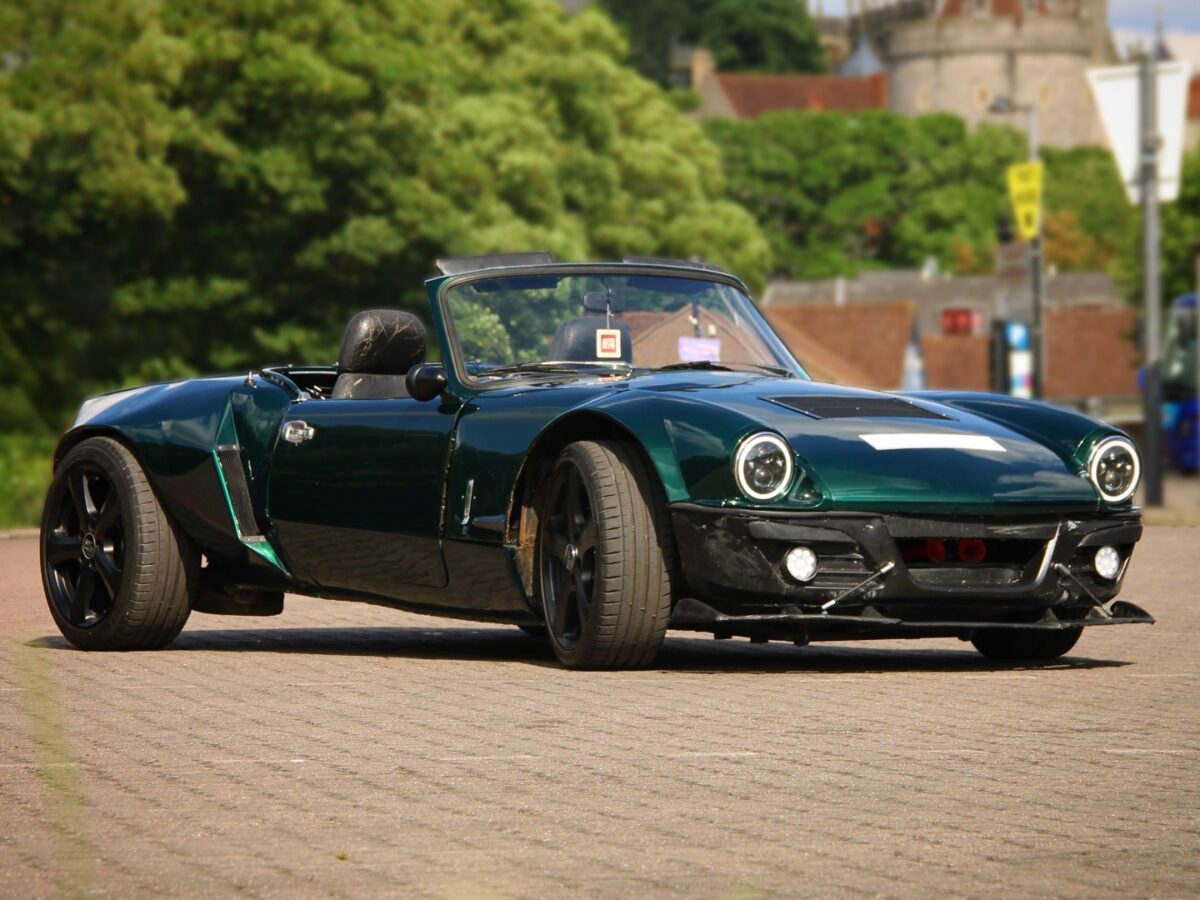
About the Triumph Spitfire 1500 (1974–80)
| OEM Spitfire 1500 | The Mid Engined Spitfire | |
| Production | 1974–1980 | 2020 |
| Production no. | 95,829 | 1 |
| Powertrain | ||
| Engine | 1,493 cc (91.1 cu in) Standard SC I4 | 1781 cm3 or 108.7 cu-in, 20 Valves |
| Fuel System | 2 SU carbs | 586cc/min Bosch fuel injectors, Bosch Me 7.5 engine management, K04-015 Turbo |
| Transmission | 4-speed manual with optional overdrive on top and third | 5-speed manual |
| Dimensions | ||
| Num. of Doors | 2 | 2 |
| Wheelbase | 210.8 cm or 82.99 inches | 240.5 cm or 94.68 inches |
| Length | 373.4 cm or 147.01 inches | 373.4 cm or 147.01 inches |
| Width | 144.8 cm or 57.01 inches | |
| Height | 120.7 cm or 47.52 inches | |
| Front Axle | 124.5 cm or 49.02 inches | 133 cm or 56.36 inches |
| Rear Axle | 127 cm or 50 inches | 152.5 cm or 60 inches |
| Ground clearance | 11.8 cm / 4.65 inches | |
| Horsepower | 71 bhp @ 5500 rpm | 280 bhp @5700 rpm |
| Curb Weight | 815 kg or 1797 lbs | 685 kg or 1507 lbs |
| Weight-Power Output Ratio | 11.3 kg/hp | 2.45 kg/hp |
| Steering | Rack and pinion | Rack and pinion |
| Front Suspension | Coil springs. Anti-roll bar | Gaz adjustable shock absorbers. Coil springs. Anti-roll bar |
| Rear Suspension | Trailing arm. Transverse leaf spring | Multilink. Coil springs. Gaz fully adjustable Lotus Elise S1 shock absorbers |
In 1973 in the United States and Canada, and 1975 in the rest of the world, the 1500 engine was used on the MK IV body to make the Spitfire 1500. Although in this final incarnation the engine was rather rough and more prone to failure than the earlier units, torque was greatly increased by increasing the cylinder stroke to 87.5 mm (3.44 in), which made it much more drivable in traffic.
While the rest of the world saw 1500s with the compression ratio reduced to 8.0:1, the American market model was fitted with a single Zenith-Stromberg carburettor and a compression ratio reduced to 7.5:1 to allow it to run on lower octane unleaded fuel,[1] and after adding a catalytic converter and exhaust gas recirculating system, the engine only delivered 53 bhp with a slower 0–60 mph time of 16.3 seconds. The notable exception to this was the 1976 model year, where the compression ratio was raised to 9.1:1. This improvement was short-lived, however, as the ratio was again reduced to 7.5:1 for the remaining years of production.
In the UK the 9:1 compression ratio, less restrictive emissions control equipment, and the Type HS2 SU carburettors now being replaced with larger Type HS4 models, led to the most powerful variant to date. The 1500 Spitfire now produced 71 hp (DIN) at 5,500 rpm, and produced 82 lb⋅ft (111 N⋅m) of torque at 3,000 rpm. Top speed was now at the 100 mph (160 km/h) mark, and 0 to 60 mph (97 km/h) was reached in 13.2 seconds. Fuel economy was reduced to 29mpg.
Further improvements to the suspension followed with the 1500 included longer swing axles and a lowered spring mounting point for more negative camber and a wider rear track. The wider, lower stance gave an impressive skid pad result of 0.87g average. This put the Spitfire far ahead of its competition in handling.
The American market Spitfire 1500 is easily identified by the big plastic over-riders and wing mounted reflectors on the front and back wings. The US specification models up to 1978 still had chrome bumpers, but on the 1979 and 1980 models these were replaced by black rubber bumpers with built-in over-riders. Chassis extensions were also fitted under the boot to support the bumpers.
Detail improvements continued to be made throughout the life of the Mark IV, and included reclining seats with “chequered brushed nylon centre panels” and head restraints, introduced for domestic market cars early in 1977 along with a new set of column stalk operated minor controls (as fitted already in the TR7) replacing the old dashboard mounted knobs and switches. Also added for the model’s final years were a wood dash, hazard flashers and an electric screen washer, in place of the previous manual pump operated ones. Options such as the hard top, tonneau cover, map light and overdrive continued to be popular, but wire wheels ceased to be available.
The 1980 model was the last and the heaviest of the entire run, weighing 1,875 lb (850.5 kg). Base prices for the 1980 model year were $5,995 in the US and £3,631 in the UK. The last Spitfire, an Inca yellow UK-market model with hardtop and overdrive, rolled off the assembly line at Canley in August 1980, shortly before the factory closed. It was never sold and is now displayed at the British Motor Heritage museum at Gaydon.